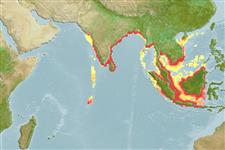Environment: milieu / climate zone / depth range / distribution range
Écologie
marin; eau douce; saumâtre; amphidrome (Ref. 51243); profondeur 0 - 50 m (Ref. 189). Tropical; 24°N - 9°S, 70°E - 118°E (Ref. 189)
Indian Ocean: India from Bombay to Calcutta, probably also Myanmar, Thailand and Malaysia. Western Central Pacific: Thailand to Java, presumably also Kalimantan). Valenciennes listed a specimen from Mahé which lies to the south of Cannanore, India but there is no such specimen in Paris.
Length at first maturity / Taille / Poids / Âge
Maturity: Lm ?, range 1 - ? cm
Max length : 20.0 cm SL mâle / non sexé; (Ref. 9822); common length : 17.0 cm TL mâle / non sexé; (Ref. 9822)
Épines dorsales (Total): 0; Épines anales 0; Rayons mous anaux: 80. Body tapering, belly rounded before pelvic fins, with 5 or 6 (rarely 4) + 7 to 9 = 12 to 15 keeled scutes from just behind pectoral fin base to anus. Maxilla short. Pectoral fin with 6 long filaments and 9 to 11 (rarely 8) branched fin rays. Flanks and belly with golden or pearly spots (light organs) in rows below scales, also along isthmus, edge of lower jaw, on cheek and gill cover.
A coastal and estuarine species, occurring in fully saline water, but also able to tolerate lowered salinities, perhaps almost fresh water. Feeds on copepods, prawn and fish larvae, various unidentified crustaceans and cypris, also stomatopod larvae, mysids, polychaete larvae, isopods and Sagitta. The breeding season is perhaps extended; probably entering estuaries to breed (larvae about 5 km up Burhabalang estuary, Orissa, India in May and June). Utilized as a food fish (Ref. 171).
Breeding season is perhaps extended. Spawn in school (Ref. 205).
Wongratana, T., T.A. Munroe and M. Nizinski, 1999. Order Clupeiformes. Engraulidae. Anchovies. p. 1698-1753. In K.E. Carpenter and V.H. Niem (eds.) FAO species identification guide for fishery purposes. The living marine resources of the WCP. Vol. 3. Batoid fishes, chimaeras and bony fishes part 1 (Elopidae to Linophrynidae). FAO, Rome. (Ref. 9822)
Statut dans la liste rouge de l'IUCN (Ref. 130435)
Menace pour l'homme
Harmless
Utilisations par l'homme
Pêcheries: commercial
Plus d'informations
RéférencesAquacultureProfil d'aquacultureSouchesGénétiqueElectrophoresesHéritabilitéPathologiesTraitementNutrientsMass conversion
CollaborateursImagesStamps, Coins Misc.SonsCiguateraVitesseType de nageSurface branchialeOtolithesCerveauxVision
Outils
Articles particuliers
Télécharger en XML
Sources Internet
Estimates based on models
Preferred temperature (Ref.
123201): 27.6 - 29.3, mean 28.7 °C (based on 640 cells).
Phylogenetic diversity index (Ref.
82804): PD
50 = 0.5001 [Uniqueness, from 0.5 = low to 2.0 = high].
Bayesian length-weight: a=0.00355 (0.00194 - 0.00650), b=3.01 (2.85 - 3.17), in cm total length, based on LWR estimates for this species & Genus-body shape (Ref.
93245).
Niveau trophique (Ref.
69278): 3.3 ±0.39 se; based on food items.
Generation time: 0.9 (0.8 - 1.0) years. Estimated as median ln(3)/K based on 12
growth studies.
Résilience (Ref.
120179): Haut, temps minimum de doublement de population inférieur à 15 mois (tm=0.5-0.6; K=1.07-1.54; Fec=1,000-5,000).
Fishing Vulnerability (Ref.
59153): Low vulnerability (14 of 100).
Nutrients (Ref.
124155): Calcium = 398 [117, 1,022] mg/100g; Iron = 2.56 [0.78, 7.00] mg/100g; Protein = 17.3 [14.5, 20.2] %; Omega3 = 0.306 [0.155, 0.612] g/100g; Selenium = 50.5 [22.8, 113.4] μg/100g; VitaminA = 18.1 [5.4, 46.9] μg/100g; Zinc = 1.62 [0.78, 3.23] mg/100g (wet weight); based on
nutrient studies.
